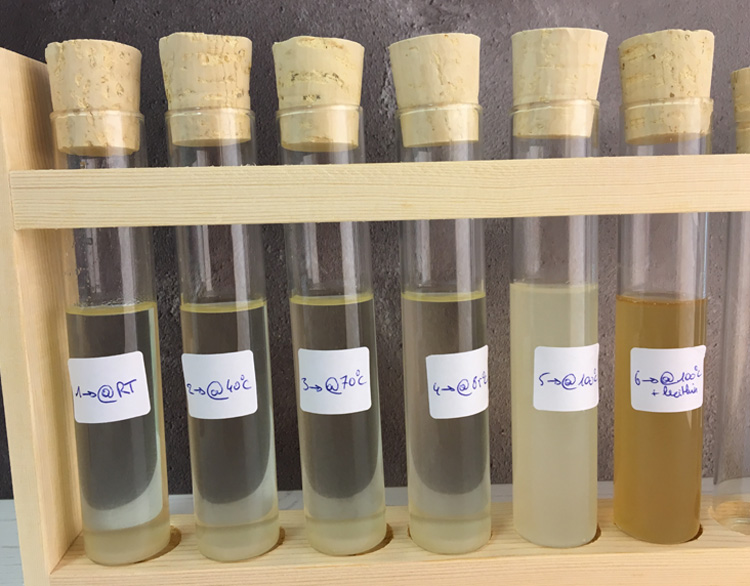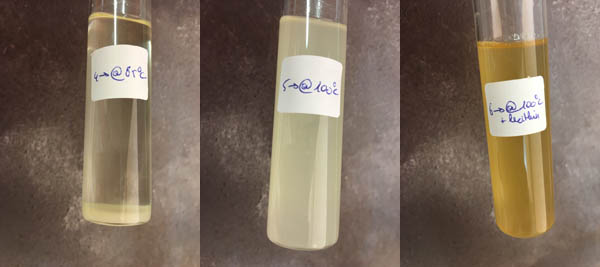Vitamin C For Missed Periods
One of the most complex issues Formula Botanica students come up against is deciding not only on the best form of Vitamin C for skin but also how to use it in their various natural skincare formulations. Vitamin C is one of the most well-known beneficial active ingredients in skincare and has been on trend for some time now.
In our first post in this series on vitamin C, we looked at the benefits of Vitamin C in high-performance skincare reviewing its action, among other uses, as a de-pigmentation agent and as an antioxidant able to scavenge free radicals. Vitamin C comes in many forms each of which has a different use and place in skincare products. As natural skincare formulators we need to understand our options to ensure we use the correct form to provide the maximum benefits in our end products.
In this second post in our series on vitamin C in natural skincare, we go over some of the most suitable and commonly-available vitamin C ingredients and also do a bit of a deep dive into their chemistry to help you understand which is best suited to your aims. Be aware that many available forms of vitamin C are not all appropriate for the home or small-scale natural skincare formulator, even if they are widely used in the professional salon world.
For more advice on what to be aware of as a small-scale, or home DIY natural skincare formulator, see also these posts:
Skincare formulation mistakes: incorrect ingredient application
8 Points you must know before making homemade skincare
Forms of vitamin C in natural skincare
As we all know, we can't be chopping up vitamin C-rich fruit and vegetables like Brussels sprouts, kiwis and cherries, or squeezing orange juice for use in our formulations. While this may be possible for DIY recipes for immediate use, we can't create long-lasting, performance skincare formulations in this manner and certainly not skincare that will pass the required safety and stability tests. Of course, the vitamin C in natural skincare products won't come directly from raw, unprocessed fruit or vegetable sources. We need to use vitamin C that is synthetically recreated in a lab.
Even though most natural cosmetics' formulators accept this, it is one of the shades of natural that is subject to debate in the natural skincare world. Formula Botanica Director Lorraine Dallmeier and school business manager Gemma Ortega Perez discuss shades of natural in organic skincare in the very first episode of our Green Beauty Conversations podcast.
Some vitamin C chemistry
L-ascorbic acid (LAA) is the chemically and synthetically active form of vitamin C. In nature, vitamin C is found in equal parts as LAA and D-ascorbic acid. The chemical and the natural variant are essentially isomeric molecules, and are interchangeable. In plain English, this means that both these substances have the same molecular formula but they have a different chemical structure (the atoms are differently connected to each other for example), and you can swap one version for the other without a problem. Vitamin C has a 5-hydrocarbon ring similar to that of glucose:
- with an attached hydrogen ion, LAA becomes a weak sugar acid similar to other alpha hydroxyl acids (better known as AHAs, used in cosmetics to promote exfoliation and thus to accelerate the turnover of skin cells); and
- with an attached metal ion, it forms a mineral ascorbate.
LAA is very unstable, however these physiologically-active and chemically-stable ascorbate molecules are a dream come true for us as formulators!
Common forms of vitamin C used in skincare
1. Ascorbic acid (water soluble):
Ascorbic acid's main use in skincare is for de-pigmentation. It achieves this by suppressing melanin formation thereby inhibiting pigmentation. It is used, for example, in products applied to address skin ageing (ageing spots), melasma, post-laser erythema, and stretch marks. All of this happens very deep into our skin. Removal of the stratum corneum by laser, chemical or mechanical methods enhances the absorption of ascorbic acid. Obviously, this type of use is the domain of professionals like dermatologists and lies outside the scope of the skincare formulator.
Disadvantages of Ascorbic Acid
Ascorbic acid is very unstable and this aspect is of huge concern and is problematic to us as natural skincare formulators. When exposed to light and/or air, ascorbic acid not only becomes inactive, but it also oxidises extremely fast to become dehydro ascorbic acid (DHAA), which further degrades to acids that are very irritating to the skin. In other words: the best case scenario is that you'll have a useless product; at worst the oxidation process creates even more free radicals ànd acidic by-products, which are very damaging for the skin.
To be effective ascorbic acid is very pH dependent. In order to be able to penetrate into our skin, the formulation requires a low (acidic) pH of less than 3.5. At this pH, the ionic charge on the ascorbic acid molecule is removed and it can be transported across the stratum corneum.
This has consequences regarding preservation when you make water-based products: most natural preservatives work at their best in the pH range 5 to 5.5. Don't forget that an acidic pH like this can cause serious stinging to the skin. These kinds of products (with a pH below 3.5) are certainly not for daily use. Chemical peels with such a low pH should be applied only by a dermatologist or a professional aesthetician.
Conclusion
The natural form of vitamin C, ascorbic acid, might be the most effective when applied topically, however, it is also the least stable version. We would also like to point out that all of this is happening in the hypodermis, which means well below the visible skin barrier. Formulations that claim skin lightening properties fall into the category of 'drugs' and not 'cosmetics'. Skin lightening agents have the potential to harm your customer if used and or formulated incorrectly. We cannot stress enough that in using ascorbic acid you need to be fully aware of what you are doing, and require very advanced formulating skills. Never forget that as a formulator you have a responsibility towards your customers.
2. Vitamin C derivatives: its esterified forms
A derivative is a compound added (like phosphate or palmitate) to help to prevent the degradation of vitamin C. Derivatives have advantages for us as skincare formulators as they are:
- not as sensitive to light and air as ascorbic acid, and so are much more stable;
- less irritating for your skin; and
- not as pH dependent.
Their disadvantage is that they are less effective than ascorbic acid. Possible derivatives include:
- ascorbyl palmitate;
- magnesium ascorbyl palmitate;
- magnesium ascorbyl phosphate;
- calcium ascorbat;
- sodium ascorbate; and
- sodium acorbyl phosphate.
Many of our students have said they are concerned about the combination of ascorbic acid and benzoic acid (a compound that regularly occurs in natural preservative blends) creating benzene, which is a carcinogenic. However, ascorbic acid esters (like our ascorbyl palmitate) are much more stable compared to ascorbic acid in its pure form. The possibility of catalysing the degradation of benzoic acid to benzene with these esters is very low. Keeping an eye on the pH of the product (stability testing, pH between 5-5.5) and applying chelators to deactivate metal ions (like copper and iron) will prevent the possibility of degradation.
We know that many of our students start by experimenting with oil-based formulations and although we do teach students how to incorporate water into their formulations to enable them to create a wider range of products, some people still prefer anhydrous products and this is absolutely fine; but you have now read that ascorbic acid and some of its derivatives are water soluble.
However, there's no need to worry if you were hoping to create some butters or balms with a focus on vitamin C; you will be happy to know that you still can. Ascorbyl palmitate is an esterified form of vitamin C and it is also oil soluble.
3. Ascorbyl palmitate: one of the best forms of vitamin C for formulators
Let's take a look at the make-up of ascorbyl palmitate (INCI: ascorbyl palmitate), which we gleaned from one manufacturer:
- It is a stable derivative of the active vitamin C.
- It is an ester of ascorbic acid and palmitic acid.
- It is oil dispersible.
The lipid solubility of palmitic acid enhances the penetration of ascorbic acid into the skin.
- It is effective at a neutral pH, which means that it is non-irritating on the skin.
- Its visual appearance is that of a whitish powder.
- It is naturally derived: ECOCERT/COSMOS approved.
Properties of Ascorbyl palmitate
It is a very potent antioxidant that can help protect the skin cells and the extracellular matrix It has high-performance benefits for mature skin, which include:
- antioxidant properties scavenging free radicals;
- stimulating collagen synthesis, which can minimise the visible sign of wrinkles;
- skin lightening because of its melanin-synthesis and -inhibiting function;
- aiding the efficacy and stability of the antioxidant (most often vitamin E) used in the formulation;
- anti-inflammatory function; and
- photo protective function.
Formulation advice Application dosage: do check with your chosen supplier as usage information can vary. We were working with Dr. Straetmans' Dermofeel Ascorbyl Palmitate.
- as product protection antioxidant: 0.1 – 0.2%
- as skincare active: 0.1 – 1%
Be aware that more doesn't always necessarily mean better! Always look for the right percentage for your product depending on the type of product you are creating and the purpose it needs to serve. Let's repeat our mantra: "As much as needed, as little as possible". Ascobyl palmitate is oil dispersible at lower temperatures, and oil soluble at higher temperatures. Here you can see a little experiment in which we tried to incorporate ascorbyl palmitate in sunflower oil at different temperatures:
- on the magnetic stirrer @ room temperature
- au bain marie @ 40°C
- au bain marie @ 70°C
- au bain marie @ 85°C
- au bain marie @ 100°C
- au bain marie @ 100°C + 0,5% lecithin

Experiment: all tubes after 48 hours.
Ascorbyl palmitate will never completely dissolve in a pure oil phase, and it will never create a transparent oil: the powder will just sink to the bottom and sit there for eternity.
- Samples below 100°C: the oil will look clear, but you will see the powder sitting at the bottom.
- Sample @ 100°C: the powder will look dissolved throughout the entire oil, but the result is very cloudy.
- Sample @ 100°C + lecithin: ideal, but this will be a little darker due to the lecithin.

Ascobyl palmitate experiment (from left): at temperatures below 100°C (our image example shows the effect at 85°C; @ 100°C; @ 100°C plus lecithin.
Ascorbyl palmitate can be easily dispersed in the hot oil phase: a temperature between 80-85°C should do it. Following this procedure, it is possible to create nice, stable anhydrous products and emulsions. Any temperature below 80-85°C will result in an unstable product. You can easily notice this when you feel grains in the finished product. Some might use this as a selling point and say this is an added 'exfoliating feature' but in fact is an unstable product. This also means that adding ascorbyl palmitate to a cold process product is a mission impossible.
It needs heat in order to be safe and stable included into the formulation. If you want to use it with a cold process emulsifier for example, you will need to go through the hassle of heating part of your formulation, and let it cool down again. Worth a try if your heart is really set on this of course.
Experiment Observations:
With this experiment I tried to show you that it doesn't make much sense to add ascorbyl palmitate in purely oil-based products as no matter which temperature you are working with, and even with the addition of lecithin, it will result in an unstable product. The powdery ascorbyl palmitate will eventually sink to the bottom and remain there.
However, ascorbyl palmitate works like a charm in anhydrous products like all kinds of balms and butters, and in emulsions. In order to be stable, you will need to add the ascorbyl palmitate to the oil/butter/wax phase and heat it up between 80-85°C, this temperature range should do the trick! If you still notice any graininess in your end product this will most likely mean you did not heat it enough and you'll need to adjust your procedure and temperature and start all over again.
In the next part of this series we will walk you through this procedure more thoroughly and we will create an anhydrous lip balm in a tube and an OW emulsion.
Top tips
When you start building your formula, think about what other kind of ingredients will be helpful, and which combination of ingredients will bring the overall formulation to another level. Try experimenting with these ingredients alongside ascobyl palmitate:
- vitamin E: because we have seen that with vitamin C and vitamin E the sum is more than the sum of its parts.
- lecithin: as a penetration enhancer
- other high performance ingredients such as carrier oils, extracts of any kind, cosmeceuticals, and so on.
Let's conclude with some wise words from Walt Disney: "I suppose my formula might be: dream, diversify and never miss an angle." In our case, we need never miss out as natural formulators in using vitamin C with its many benefits and in finding an optimal form suited to the home formulator rather than the professional salon.
FAQs
Which vitamin C is best for skin?
Vitamin C, L-ascorbic acid (LAA), is the chemically and synthetically active form of vitamin C. However, it is notoriously unstable and prone to oxidising. This makes it unsuitable for most natural cosmetic formulations and it is use primarily in professional salon treatments. One of the best choices of vitamin C as an ingredient is Ascorbyl palmitate (INCI: Ascorbyl palmitate). This is a stable derivative of the active vitamin C, an ester of ascorbic acid and palmitic acid and is dispersed in oils. It is a potent antioxidant and of great benefit in high-performance skincare aimed at mature skin.
Does vitamin C make your skin better?
Stable Vitamin C derivative ingredients that are chosen carefully for their properties and used in the appropriate cosmetic formulation can be of great benefit in high-performance skincare. Vitamin C forms such as Ascorbyl palmitate can help reduce the visible appearance of hyperpigmentation spots on the epidermis. As an effective free radical scavenger, vitamin C can neutralise free radicals that cause oxidative stress in the skin. It also aids in promoting collagen synthesis and in the regeneration of alpha-tocopherol (vitamin E) levels which helps counteract the effects of free-radical skin damage.
Is putting vitamin C on your face good?
Professionally-formulated cosmetics use very specific derivative, synthesised forms of vitamin C to create high-performance skincare to target issues such as hyperpigmentation. Crushing and hydrating readily available forms of vitamin C such as food supplements in tablet or powdered form or using raw vitamin C-laden fruit on your skin may not harm it but may not do much in terms of changing the appearance of any epidermal skin issues. As a cosmetic ingredient, vitamin C derivatives need to be formulated professionally in order to work as desired and in synergy with other ingredients in the cosmetic formulation.
Where can I learn to formulate natural skincare and haircare products?
Join us at Formula Botanica, where tens of thousands of students and followers take our free and paid online courses to learn how to formulate organic skincare and haircare for themselves or to sell.
Leave us a comment

Jilly Schechter is a Tutor at Formula Botanica, where she helps our students to become better organic cosmetic formulators. Jilly lives in Belgium and loves writing tutorials on how to make skincare and haircare.
Source: https://formulabotanica.com/best-form-vitamin-c-in-natural-skincare/

0 komentar:
Posting Komentar